360-degree immersive video apps: Why you should create meaningful research-based digital resources to engage learners

Editor’s Note: Dr. Tarsem Singh Cooner is a Senior Lecturer in the Department of Social Work and Social Care at the University of Birmingham. In this post, he describes why and how he developed 360-degree immersive video apps to create engaging learning opportunities for students. Additionally, his work shows how digital tools can be used to creatively disseminate research findings to practitioners. Dr. Cooner tweets at @Akali65. You can also email him at t.s.cooner@bham.ac.uk.
The background
Quite recently I was lucky enough to be part of a fantastic research project exploring factors that can either enable or create barriers to effective child protection social work. Our project had collected a lot of data that we were convinced could have a really positive impact on child protection services. To disseminate our research in a more accessible, meaningful, situated and impactful way, I led an initiative within the team to create a set of 360-degree immersive video apps that social work students and practitioners can download onto their smartphones via the iTunes and Google Play Stores. Using their phones with easily accessible 360-degree headsets (like Google’s Cardboard) they can become ‘immersed’ in our work through recreated scenes from our research experiences.
Why 360-degree immersive videos?
The problem
At the beginning of our research study we decided to disseminate our findings through traditional methods such as journal publications, conference presentations, workshops, reports etc. However, to make our research more accessible we had to overcome something highlighted to us over and over again by the practitioners we followed during our fieldwork. The social workers in the study were naturally curious about our findings and wanted to know how they could access them after we had left the field. When we told them about our original dissemination ideas, many outlined how issues such as a lack time to read journal articles, reports, problems accessing journal papers behind paywalls, often inaccessible academic writing styles and problems attending conferences, workshops etc all combined to make the research difficult to access.

The solution
So, we found ourselves in a situation where for the research to have a positive impact in child protection social work, we had to creatively overcome a number of barriers that would allow our core audiences to access the messages from our analysis. One creative answer was to produce a set of 360-degree immersive video apps. This digital medium made sense because our research methodology was based on an ethnographic approach where we followed social workers on foot, in their cars and around their offices. We sought to make visible not only what they did, but also what they thought, and how the emotional dynamics, tone, body language, atmospheres etc during home visits, supervision and in their offices all impacted on how they experienced and undertook their work. For more background about the approach please see video:
Social work and digital media
I’ve always been fascinated with the potential digital technologies can offer in allowing us to ‘bottle learning experiences’. As educators this ability to draw on a digital resource means that we can select the optimal moment to maximise a student or practitioner’s learning experiences. If designed well, the medium can offer profoundly deep and meaningful learning experiences at multi-sensory levels. 360-degree immersive video apps can lead to these types of learning experiences because the medium allows the learner to feel a sense of ‘presence’ that is difficult to recreate using other media. We designed the apps so that the learner is able to have ‘the best seat in the house’ and follow us as researchers on home visits to experience what we experienced. This approach enabled us to take the research off the page and transport the learner into a digital space where they could experience changes in tone, body language and atmospheres. Learners were also able to get a sense of the layout and condition of the family home, the anxiety the social worker may feel prior to or during a home visit. Having the ability to transport the learner into these digital spaces enabled them to learn vicariously about the factors our research suggested can either create enablers or barriers to effective child protection work.
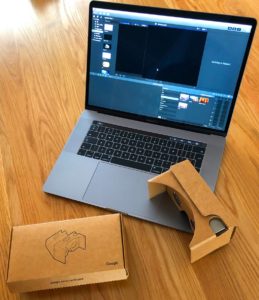
Don’t I need a big team to create apps?
To create the apps, I used a MacBook Pro laptop, Apple’s Final Cut Pro video editing software and an online website called InstaVR. Working at the intersection of technology, research-based content and creative digital design, I was able to create and publish the apps using a small grant awarded by the University of Birmingham. I argue that this approach means that with a little bit of confidence and a good idea, it is possible for us all to create these types of resources for the social work community. The advantage of not relying on technicians to produce the materials is that what you produce as a social worker, will in all probability, be very close to the original vision of your learning resource compared to something filtered through a technologist’s interpretation of your idea. Seriously, it’s not that difficult to produce these types of digital materials, I would encourage you to give it a go!
Evaluation
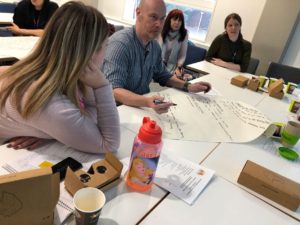
We’ve undertaken a number of workshops with social work students, newly qualified and experienced child protection social workers and managers. The evaluations have been very positive. In general, when using the apps with 360-degree viewers the participants have reported that they have:
- felt as though they were ‘present’ in the home visits and could feel the emotions in the scenes
- felt fully immersed in the scenes using the headsets because there were no other distractions
- been able to experience the atmospheres and tone of the engagement and how it shaped the outcome
- learned through observation how body language can convey underlying messages in highly stressful situations
- reflected on the impact of the home environment
- become prepared to identify and de-escalate challenging situations by experiencing them first using the 360-degree scenarios
- become aware of some the research messages identifying the enablers and barriers to successful engagement with children and families in their homes
- felt a sense of empathy for the social worker and/or family members during the engagement
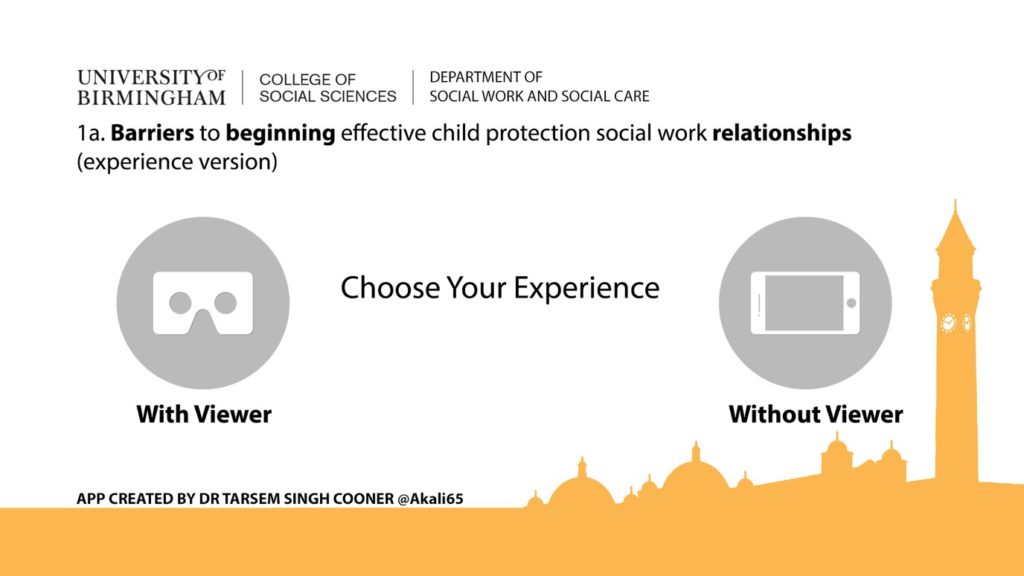
Screenshot of Child Protection app from mobile device illustrating the ‘with’ and ‘without’ viewer functions. 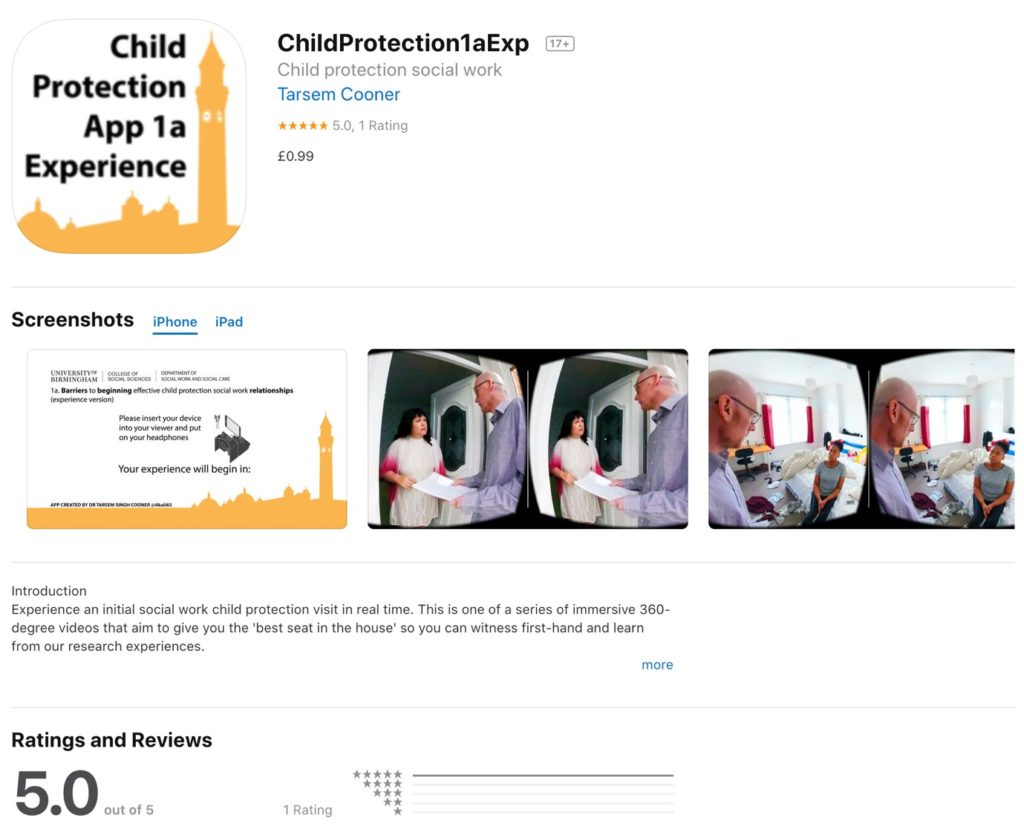
Screenshot on mobile device of one of the apps from Apple’s App Store.
Many of the workshop participants reported that this was an excellent way to engage with our early research messages because they tended to describe themselves as visual learners.
A very small minority of participants did report feelings of dizziness and motion sickness when using the 360-degree headsets. They were however still able to use the apps by utilizing the ‘without viewer’ function built into the apps.
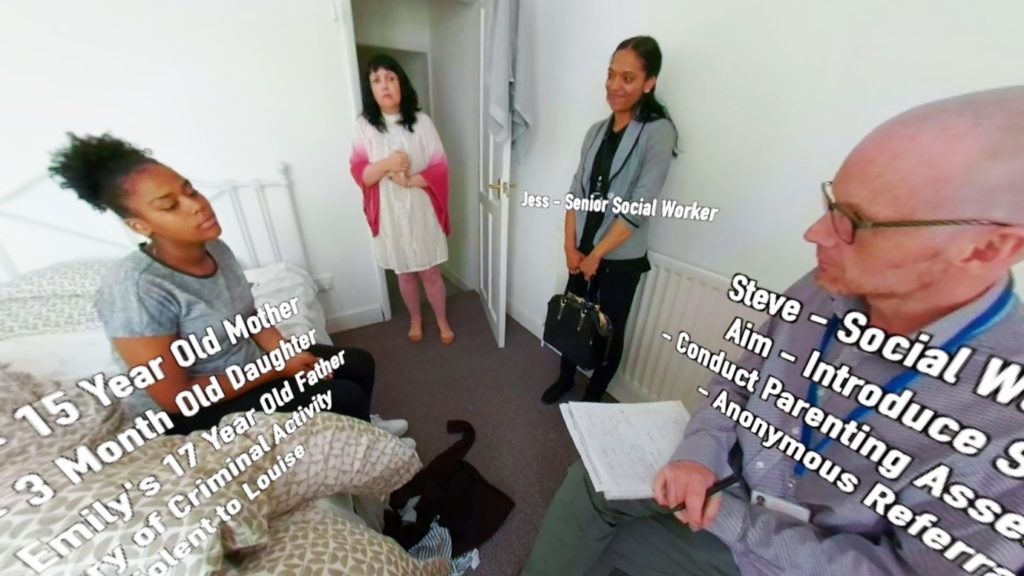
Screenshot of 360-degree immersive video scene from app 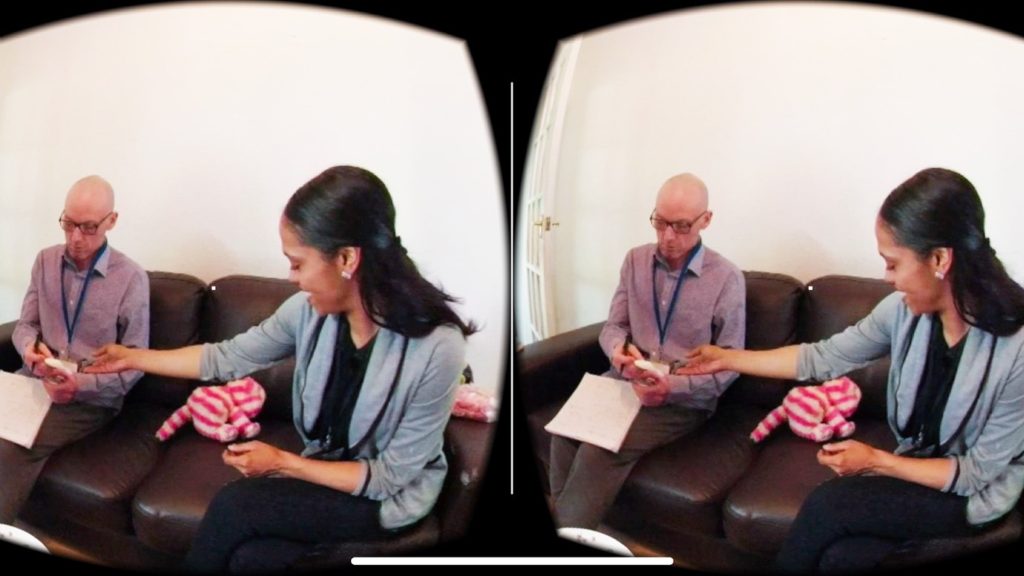
Screenshot of 360-degree immersive video scene from app
A challenge
As social work educators and researchers we must use technology creatively and shape it to our needs. Digital technology can have a profound effect on the way that social work education and training can be enhanced to make learning experiences more relevant and powerful. These experiences can help to shape successful future interventions. From my experiences of this project, I encourage you to take a leap of faith, be creative, be prepared to make and learn from mistakes. There are many tools available now that make the production of digital learning materials so much easier than was the case in the past. Go on, give it a go create something wonderful for the social work community!
Do you have any ideas for 360-degree immersive video apps? Any thoughts on how you could use our child protection experiences in your own teaching and learning? Please let me know by adding a comment below.
To learn more about the apps and the research project please visit: https://swcpp.weebly.com/360-degree-immersive-apps.html
How to cite this blog post:
Cooner, T.S. (2019, July 31). 360-degree immersive video apps: why you should create meaningful research-based digital resources to engage learners [Blog Post]. Retrieved from: https://laureliversonhitchcock.org/2019/07/31/360-degree-immersive-video-apps:-why-you-should-create-meaningful-research-based-digital-resources-to-engage-learners/


